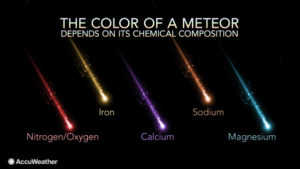Reprinted from: https://www.accuweather.com/en/space-news/2-meteor-showers-to-peak-at-same-time-on-tuesday-night/782062
Updated Jul. 26, 2020 11:13 PM
As Comet NEOWISE fades away, stargazers will have a new astronomical event to look for in the final days of July—a phenomenon that hasn’t happened in nearly three months.
On the night of Tuesday, July 28, into the early morning hours of Wednesday, July 29, shooting stars will glisten in the night sky from not one, but two meteor showers: The southern Delta Aquarids and the Alpha Capricornids. The last time that a moderate meteor shower put on a show in the night sky was the Eta Aquarid shower in early May, but clouds were an issue for many stargazers across North America.
Neither of the two showers this week are considered major, but together they will bring around 15 to 20 meteors per hour in dark areas away from light pollution. The Alpha Capricornids is the weaker of the two meteor showers, but it could prove to be the one that is most intriguing.
“What is notable about this shower is the number of bright fireballs produced during its activity period,” the American Meteor Society (AMS) explained.
(Visit the link above for a spectacular fireball video)
Fireballs are incredibly bright meteors that can light up the entire night sky for a few seconds. They also are visible for much longer than the typical shooting star, glowing for several seconds as they streak through the sky.
“Vivid colors are more often reported by fireball observers because the brightness is great enough to fall well within the range of human color vision,” the AMS said.
“The dominant composition of a meteoroid can play an important part in the observed colors of a fireball, with certain elements displaying signature colors when vaporized.”
 Skywatchers planning to head out for the celestial double feature on Tuesday night might want to put on a pot of coffee as they are best seen after about 1 a.m. local time.
Skywatchers planning to head out for the celestial double feature on Tuesday night might want to put on a pot of coffee as they are best seen after about 1 a.m. local time.
This is the time when the moon is setting, meaning that there will be less light pollution in the sky during the second half of the night. It is also the time when the radiant point of the two showers starts to climb high in the sky.
The radiant point is simply the area in the sky where the meteors originate. As the radiant point moves higher in the sky, onlookers will be able to count a greater number of meteors. Both the southern Delta Aquarids and the Alpha Capricornids have a radiant point in the southern sky, close to Saturn and Jupiter, but meteors will be able to be seen streaking across all areas of the sky, not just to the south.
The only things that people will need to be able to see the two meteor showers are a clear view of the night sky and cloud-free weather conditions.
The best viewing conditions on Tuesday night are expected across the Great Lakes, the interior West and the northern Canadian Prairies.
Clouds are likely to be an issue for much of the Plains and the East Coast, but some pockets could have enough breaks in the clouds to catch part of the show.
